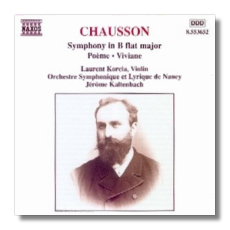
The Internet's Premier Classical Music Source
Related Links
- Chausson Reviews
- Latest Reviews
- More Reviews
-
By Composer
-
Collections
DVD & Blu-ray
Books
Concert Reviews
Articles/Interviews
Software
Audio
Search Amazon
Recommended Links
Site News
 CD Review
CD Review
Ernest Chausson

- Symphony in B Flat Major, Op. 20 (1890)
- Poeme for Violin & Orchestra, Op. 25 (1896)
- Symphonic Poem "Viviane" on a Legend of the Round Table, Op. 5 (1882)
Larent Korcia, violin
Orchestre Symphonique et Lyrique de Nancy/Jeröme Kaltenbach
Naxos 8.553652
This turned out to be a study in Chausson. I pulled out every other recording I have of this piece and spent several days comparing and contrasting them. For the record, I have Plausson's recording on EMI (64686) Fournet on Denon (3675, nla?) and Monteux's on RCA (9026-61899) in addition to this latest release. The latest Schwann Opus in my collection (Summer 1997….I get one each summer and haven't gotten this year's as yet) lists 7 recordings of the piece. I had, at one time, Mata's on Delos but parted with it some time ago.
I also read what was available in insert notes about the composer. He lived from 1855 to 1899, dying after a freak bicycle accident. Only the last twenty years of his short life, however, were spent "doing music". I use this phrase because another source I read was a brief review of some of his chamber music by Stratton Rawson in one of the major classical music journals. In it he argues that Chausson's "…music seems to be about 'doing'; he seems unconcerned with the memorableness or the import of the artifact he leaves behind…". If the impressionists shifted their concern from subjects like irises to the light that surrounds the subject, Chausson shifted his concern from the drama of harmonic shifts to the way the elements of music affect time." I have quoted this passage not because I agree with all of it, but because it seems a good point of discussion.
I find I am able to approach Chausson better when I think of his music as being of light and shadows. Much like magicians create their effect with smoke and mirrors, Chausson affects me with a similar magical touch. This is more so in the two shorter works on this disc than in the symphony. If you have the ability to hear in colors (I envy that) these pieces will absolutely transport you to an impressionist's world. "Poeme" is Chausson's most popular piece, often featured on collections of short works by violinists. This recording certainly captures the shadows and light. The 'Viviane' is based on Arthurian Legend which may seem a bit odd coming from a Frenchman. This tone poem is absolutely fascinating. It is also on the EMI disc, but does not make nearly the impression (pun???) as on the Naxos release.
On a couple of occasions I have been driving and will come in on the symphony during a broadcast from a public radio station. I usually spend the next several minutes trying to figure out who it is. Franck comes to mind, all the gestures are there, but it is not Franck. D'Indy's Symphonie sur un chant montagnard francais also comes to mind, but that, too, is discarded. Gradually Chausson's personality emerges. The symphony is more 'memorable' and so may pose a bit of a challenge to Mr. Rawson's theory. It is, however, a more structured medium in some ways which may account for several 'memorable' tunes. The transition from the slow, moody opening movement swirling to a whole new mood is one such moment that defines this work. The third movement has some of the most beautiful, almost Wagnerian moments. On the other hand, you can hear the flow of light and shadows within the movements, a sense that time has been transformed. So, perhaps Mr. Rawson is correct after all.
This particular recording of the symphony brings to mind, more than the others I have heard, Monteux's recording with the San Francisco Symphony in 1950. That recording must be heard if you really want to get a feel for the piece. Monteux invests the work with a passion and drive unparalleled by anyone else. The sound may take a few minutes to adjust to, but it is worth the time. After hearing it again, in the process of writing this review, I was drained by the experience and listened to nothing else that evening. The next day, however, I turned to listen to the Naxos recording again. I found I now appreciate the piece, and this particular recording, more than before. Monteux made an aural imprint on me so I now have a map.
As I mentioned, so long ago, I have two other 'current' recordings of this in my collection. I have to rule out the Denon recording because the final movement seems to drag to me. The sound is superb, but this is no longer in the catalogue anyway. The EMI recording has the advantage of being an all-Chausson recording, like the Naxos, but the sound is not as good. I must warn you that Kaltenbach takes the second movement almost a minute slower than any of the other recordings considered. On the other hand, I appreciated the opportunity to linger a bit over the melodies. The Naxos sound is realistic. The timpani are perfectly placed in the aural picture, the harp is delicious and the strings sweet when need be and dark when need be. All in all, another fine Naxos contribution to recorded classical music.
Copyright © 1998, Robert Stumpf II


















